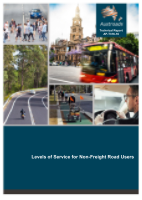Asset Management

- Publication no: AP-T316-16
- ISBN: 978-1-925451-45-0
- Published: 23 November 2016
- PDF (free) Download
This report documents the results of an Austroads project to identify the asset management needs and level of service (LOS) requirements of future non-freight road users.
Preliminary work documented the relationship of this project to other Austroads projects, reviewed overseas and Australian work in the area, and established definitions and terminology. This allowed development of a LOS framework and a questionnaire to investigate users’ views on key issues.
The questionnaire survey was conducted with 1920 respondents across Australia and New Zealand.
Key findings were that there was little difference between the responses from Australian and New Zealand respondents, and that there was little difference in the importance ratings given to different road user needs according to region within these countries. There were regional differences in the acceptability of how these needs were catered for, with metropolitan respondents generally giving higher acceptability ratings than regional or remote respondents.
The survey results were shared with agencies in a series of workshops, in which progress by the individual agencies was also discussed. Agencies have followed different paths in their development of LOS frameworks but are all close to a stage where they may benefit from a co-ordinated approach. The original LOS framework was developed further to include acceptability functions, i.e. empirically determined relationships between the physical state of an asset and the degree of user acceptability.
The report concludes by indicating how acceptability functions could be obtained and used to develop customer-focussed LOS criteria that are firmly grounded in customers’ assessments of the road system.
- Summary
- 1. Introduction
- 1.1. The Project
- 1.2. Structure of the Report
- 1.3. Making a Start
- 1.3.1. Projects from the Network Program
- 1.3.2. Projects from the Assets Program
- 1.4. Anticipating Future Requirements
- 1.4.1. Future Road User Needs
- 1.4.2. The Ageing Population Needs
- 1.4.3. Possible Future Public Transport Needs
- 1.4.4. Pedestrians
- 1.4.5. Cyclists
- 1.5. Possible Future Vehicle Technologies and Their Impacts
- 1.6. Summary
- 2. Asset Management Needs and LOS Frameworks
- 2.1. Terminology
- 2.2. Reported Asset Management Needs from Road/Transport Users
- 2.2.1. 2014 RACV Regional Victoria Growing Pains Survey
- 2.2.2. 1998–2004 ARRB Road User Surveys on LOS Expectations in Australia
- 2.3. Reported Asset Management LOS Frameworks
- 2.3.1. USA National Cooperative Highway Research Program (NCHRP) Framework
- 2.3.2. New Zealand State Highway Asset Management Plan (SHAMP)
- 2.4. LOS Frameworks from the AT1737 Project Team
- 3. Survey of Road User Opinion
- 3.1. Developing the Questionnaire
- 3.2. Method
- 3.3. Results
- 3.3.1. Critical Attributes of the Road Transport System
- 3.3.2. Importance of Road Characteristics
- 3.3.3. Comparison across Regions
- 3.3.4. Current State of Roads
- 3.3.5. Comparison across Regions
- 3.3.6. Current State of Pedestrian Facilities
- 3.4. Key Findings
- 3.5. Implications for Developing a LOS Framework
- 4. Current Progress with LOS in Member Agencies
- 4.1. Workshop Discussions with Member Agencies
- 4.2. Current Developments in Member Agencies
- 4.2.1. New Zealand
- 4.2.2. Tasmania
- 4.2.3. Western Australia
- 4.2.4. New South Wales
- 4.2.5. VicRoads
- 4.2.6. TMR
- 4.2.7. LOS Framework for the ACT
- 4.3. Comparison across Agencies
- 4.4. Overview of Progress in Member Agencies
- 4.5. Towards a Framework for LOS
- 4.5.1. Need and Narrative
- 4.5.2. Measurement
- 4.5.3. User Needs
- 4.5.4. Developing Strata or Criteria
- 4.5.5. Operational Requirements
- 5. Proposed Framework and its Relation to Work in Member Agencies
- 6. The Way Forward
- 6.1. Issues to be Resolved
- 6.2. Next Actions
- References
- Appendix A Survey of Road User Views and Priorities
- A.1 Introduction
- A.2 Developing the Questionnaire
- A.3 Method – Main Survey
- A.3.1 Sample Design
- A.3.2 Interview Method
- A.3.3 Conduct of Interviews
- A.4 Results, Australia
- A.4.1 Agreement with Sampling Plan
- A.4.2 Travel Activity of Respondents
- A.4.3 Age and Gender Differences
- A.4.4 Overall Performance of the Transport System
- A.4.5 Comparison across Regions
- A.4.6 Importance of Road Characteristics
- A.4.7 Comparison across Regions
- A.4.8 Current State of Roads
- A.4.9 Comparison across Regions
- A.4.10 Current State of Pedestrian Facilities
- A.4.11 Factors that Would Increase Active Transport
- A.4.12 More Public Transport Use
- A.4.13 More Walking
- A.4.14 Local Roads for Recreational Trips
- A.4.15 Better Use of Existing Roads
- A.4.16 Critical Attributes of the Road Transport System
- A.4.17 Suggestions for Improvements to the Road Transport System
- A.5 Results, New Zealand
- A.5.1 Structure of the Sample
- A.5.2 Overall Performance of the Transport System
- A.5.3 Comparison across Regions
- A.5.4 Importance of Road Characteristics
- A.5.5 Comparison across Regions
- A.5.6 Current State of Roads
- A.5.7 Comparison across Regions
- A.5.8 Current State of Pedestrian Facilities
- A.5.9 Comparison across Regions
- A.5.10 Factors that Would Increase Active Transport
- A.5.11 More Public Transport Use
- A.5.12 More Walking
- A.5.13 Local Roads for Recreational Trips
- A.5.14 Better Use of Existing Roads
- A.5.15 Critical Attributes of the Road Transport System
- A.5.16 Suggestions for Improvements to the Road Transport System
- A.6 Key Findings
- A.7 Implications for Developing a LOS Framework
- A.8 Driver Questionnaire
